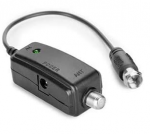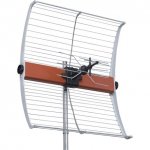Scanners have band filters that stops out of band signals. Your antenna has an inbuilt amplifier so it will overcome any coax losses you have in the 800MHz band, or other bands. The amplifier are designed for television sets that would overload if the amplifier where designed badly, much more so than a scanner. So no problem in that respect to be used with a scanner. It has a noise figure of 2,5dB so it is considered low noise and very good.
Most scanners use a capacitor in line with the antenna signal so no DC voltage could damage the scanner. In some cases there are diods at the antenna port that protects from high voltage RF signals entering the electronics in the scanner. If you connect that power inserter backwards it could short circuit the power adapter and the green LED will go out until you disconnect it. But it is clearly marked "antenna" so shouldn't be a problem once you have it setup.
If you get problems with overload you can use an attenuator between that power inserter and scanner to reduce the signal, something like this:
The antenna use several front elements, directors, that are tuned to 700-900Mhz and the active folded dipole seems to be tuned to 500-600MHz and the reflector element are something like a 200MHz lenght. So not so much FM broadcast reception and also less 150MHz paging interference. You should have the antenna tilted to vertical, and not horizontal as it is in the amazon picture.
/Ubbe
 <-- Amplifier
<-- Amplifier <-- Amplifier
<-- Amplifier


